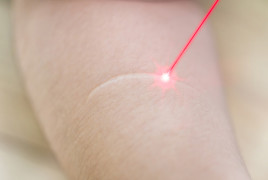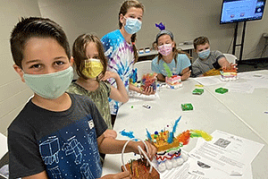Cutaneous T-cell lymphoma: Diagnosis & treatment
Think you might have cutaneous T-cell lymphoma?
See a doctor who has experience with it. You’ll find dermatologists who have experience with cutaneous T-cell lymphoma at Find a Dermatologist. Click on "Filters". Select "Any condition" and choose "Cutaneous lymphoma."

How do dermatologists diagnose cutaneous T-cell lymphoma?
Because the first noticeable signs often appear on the skin, many people see a dermatologist to find out what’s causing their skin problem.
It’s important to understand that it takes time to diagnose cutaneous T-cell lymphoma, also called CTCL. If your dermatologist believes that you may have a type of this cancer, your dermatologist will:
Give you a complete skin exam, checking your skin for signs like rashes and plaques.
Run blood tests.
Perform a skin biopsy, to check for cancer.
Ask what medications you take.
Early cutaneous T-cell lymphoma can be difficult to find because:
A skin biopsy often doesn’t show cancer cells. This type of cancer can be difficult to find with one biopsy. To get an accurate diagnosis, you may need multiple skin biopsies over time.
Blood tests may not show cancer cells.
These cancers can look like a common skin condition, such as eczema or psoriasis, so your dermatologist will have to rule out these conditions.
For these reasons, it’s important to keep all your dermatology appointments. This helps your dermatologist see what’s happening to your skin over time and order medical tests as needed.
If tests show that you have a type of cutaneous T-cell lymphoma, the next step is to find the stage of the cancer. Stage tells you and your doctors whether cancer is found only in your skin or has spread to another part of your body.
To find the stage, you’ll need medical testing. This may include a chest x-ray, CT scan, or other tests.
How is cutaneous T-cell lymphoma treated?
Treatment depends on the type of cutaneous T-cell lymphoma you have and the stage of the cancer.
Found early, cutaneous T-cell lymphoma is generally not deadly. With proper treatment, many people live long lives and living with this cancer is more like having a chronic disease that you need to manage.
Patients who have an early-stage cancer may receive treatment from a dermatologist and sometimes a radiation oncologist (doctor who specializes in treating cancer with radiation).
Are you taking any medications or supplements?
Be sure your doctors know all the medications and supplements you take. Certain ones, including antacids, turmeric, and green tea extract, can prevent treatment from working.

Some patients see a team of doctors. This team may include your dermatologist, a hematologist (doctor who treats blood diseases) or an oncologist (doctor who treats cancer), and a radiation oncologist.
The goal of treatment is usually to achieve one of the following:
Reduce symptoms (aka symptom control): The goal of this type of treatment is to help you feel better without compromising your quality of life.
Symptom control is often the goal for patients who have mycosis fungoides, the most common type of cutaneous T-cell lymphoma. Mycosis fungoides tends to advance slowly, so symptom control can help you live life with minimal disruptions.Remission: When cancer goes into remission, signs and symptoms are reduced. Complete remission means that all signs and symptoms of cancer disappear.
During treatment, pain and other possible side effects may reduce your quality of life or leave you less able to perform everyday activities. Keeping the goal of treatment in mind can help get you through this difficult period.
A treatment plan for cutaneous T-cell lymphoma may include one or more of the following types of treatment.
Treatment for the skin
To destroy cancer cells found in the skin, you may need to apply medication to your skin, have radiation therapy, or get light treatments. Some patients receive a combination of these treatments.
Medication you apply to your skin: This type of treatment can kill cancer cells in the skin as well as relieve swelling and itch. These medications include:
Corticosteroid: When applied to the skin, this medication can treat cancer and help to reduce inflammation. Less inflammation often means less swelling, itch, and pain. Due to possible side effects, this medication is prescribed to treat small areas of skin.
Bexarotene gel and tazarotene gel or cream: These medications are used to stop or slow growing cancer cells.
You apply the medication to your skin as directed. Bexarotene is usually applied 3 to 4 times a day. With either medication, it can take months to see improvement.Brand names: Targretin (bexarotene gel), Tazorac (tazarotene)
Nitrogen mustard gas (mechlorethamine gel): This is chemotherapy that you apply to your skin. It can slow or stop the growing cancer cells. The U.S. Food and Drug Administration (FDA) has approved this medication to treat the most common type of cutaneous T-cell lymphoma, which is mycosis fungoides, in its earliest form.
This medication is usually applied once a day. It can take months to notice improvement.Brand name: Valchlor
Carmustine ointment: This is a topical (aplied to the skin) chemotherapy medication used to treat cutaneous T-cell lymphoma. It’s usually applied for 12 weeks.
Brand name: BCNU
Imiquimod: This medication works by stimulating your immune system. It can be effective in treating early-stage cutaneous T-cell lymphoma.
Brand names: Aldara, Zyclara
Light treatments: Also called phototherapy, this treatment uses a precise, prescribed amount of light to kill cancer cells in the skin.
To receive light treatments, you typically stand in a device called a light box for a specific amount of time. Some patients take a medication called psoralen before standing in the light box. This medication makes the skin more sensitive to the light. When you take psoralen first, the phototherapy is called PUVA.
To receive light treatments, you must go to a treatment center that offers phototherapy. This could be in your dermatologist’s office or a hospital.
Light treatments are typically given 2 to 3 times per week. Most patients need about 20 to 30 light treatments to know whether this treatment is effective.
For many people who have a darker skin tone and light spots on their skin caused by this cancer, phototherapy can put the cancer in remission (reduce symptoms). Phototherapy can also return lost color.
For patients with early cancer, phototherapy may be their only treatment. Sometimes, both phototherapy and medication applied to the skin are used to treat early cancer.
Radiation therapy: Radiation therapy is used to kill cancer cells and shrink tumors. It's often part of a treatment plan for cutaneous T-cell lymphoma.
Radiation therapy can be quite effective for clearing the cancer on the skin. It may be used to get rid of plaques and other signs of cutaneous T-cell lymphoma that don't clear with phototherapy. Some patients have a complete response (no sign of cancer) after receiving radiation therapy.
Radiation can be prescribed to treat only certain areas of the skin or the entire body. One type, electron beam radiation therapy, sends radiation only to the outer layers of the skin.
For patients with advanced cancer, radiation therapy may be prescribed to help them feel better. For example, slowing or shrinking tumors can help ease pain and discomfort caused by advanced cancer.
Radiation therapy is given at a treatment center or hospital.
Medication that works throughout the body: Several of these medications are used to treat the different types of cutaneous T-cell lymphoma. Here are different types of medications that work throughout the body that may be prescribed:
Targeted therapy: This type of cancer medication works by targeting specific areas on cancer cells that help the cancer grow and survive.
The FDA has approved one targeted-therapy medication:Brentuximab vedotin is FDA approved to treat patients who have a type of cutaneous T-cell lymphoma called systemic anaplastic large cell lymphoma (sALCL) and some patients with advanced mycosis fungoides.
Brentuximab vedotin is designed to attach to the surface of cancer cells and deliver vedotin to kill the cancerous cells.
For brentuximab vedotin, treatment is given intravenously (by IV), so you’ll need to go to a treatment center that offers infusions. Patients receive an infusion once every 3 weeks. How many infusions you receive depends on how your body responds to the medication.Brand name: Adcetris
Targeted immunotherapy: This type of medication targets cancerous T-cells in your body and then helps your immune system find and kill the cancerous cells.
The FDA has approved the following targeted immunotherapy medications for cutaneous T-cell lymphoma:Denileukin diftitox-cxdl is FDA approved to treat adults who have stage I, II, or III cutaneous T-cell lymphoma. It’s prescribed when the cancer has not responded to other treatment, or the cancer has returned.
This medication is given intravenously (by IV), usually for 5 consecutive days every 21 days. You’d continue to get infusions every 21 days. Patients stop treatment if the cancer worsens or the side effects of the medication become unacceptable.
To receive treatment, you’ll go to a treatment center that offers infusions. Each infusion takes about 1 hour.Brand name: Lymphir
Mogamulizumab-kpkc is FDA approved to treat adults who have tried at least one other treatment for mycosis fungoides or Sézary syndrome, only to find that the cancer came back.
Mogamulizumab-kpkc is given intravenously (by IV), so you’ll need to go to a treatment center that offers infusions. The infusions are usually given once a week for 4 weeks, and then once every 2 weeks. How many infusions you receive depends on how your body responds to the medication.
Each infusion takes at least 1 hour.Brand name: Poteligeo
HDAC inhibitor: This type of medication can stop or kill cancer cells. The FDA has approved two of these medications to treat cutaneous T-cell lymphoma:
Romidepsin is FDA approved to treat people who have cutaneous T-cell lymphoma and have already tried at least one other medication that works throughout the body. Romidepsin works by slowing the growth of cancer cells. This medication is given intravenously (by IV), so a nurse or other medical professional will treat you.
Each infusion takes at least 4 hours, and you receive treatment once a week.Brand name: Istodax
Vorinostat is approved to treat people whose disease has not improved, worsened, or comes back after taking other medications. It can kill cancer cells or stop them from growing.
If vorinostat is prescribed, you’ll take a capsule, usually with food. Your doctor will tell you how often to take it. Be sure to take this medication exactly as prescribed. If you have any questions about how to take it, ask your pharmacist or doctor.Brand name: Zolinza
Oral retinoids: This type of medication has been used for years to treat cutaneous T-cell lymphoma. It can stop the growth of cancer cells.
The FDA has approved one oral (take by mouth) retinoid, bexarotene, to treat the tumors and other signs of cutaneous T-cell lymphoma on the skin. Due to possible side effects, patients must have tried at least one other medication that works throughout the body before they are prescribed this retinoid.Brand name: Targretin
Chemotherapy: Methotrexate is a chemotherapy medication used to treat many different cancers. When prescribed to treat cutaneous T-cell lymphoma, methotrexate is used to slow down or stop tumors and plaques from growing on the skin.
Brand names: Jylamvo, Rheumatrex, Trexall, Xatmep
Interferon: Our bodies naturally produce interferon. It’s part of the immune system’s response. Pharmaceutical companies also make synthetic interferon. This interferon is used to treat the most common types of cutaneous T-cell lymphoma, mycosis fungoides and Sézary syndrome.
Brand names: Actimmune, Roferon A
Clinical trial: If the cancer has advanced, a clinical trial may be your preferred treatment.
A clinical trial is a research study. It allows scientists to find out how well a new medication or other treatment can treat or prevent a disease. Many of today’s medications and other treatments would not exist without clinical trials. There are benefits and risks to joining a clinical trial.
While your doctor can give you information about a clinical trial, only you can decide whether one is right for you.
Photopheresis: Also called extracorporeal photopheresis, this is a procedure. It’s meant to help your immune system fight cancer.
This procedure begins with a blood draw. The blood taken from your body is placed into a machine that separates your white blood cells from the rest of your blood.
Your white blood cells are then exposed to UVA light after being treated with a medication that makes them more sensitive to light. Your treated white blood cells are then returned to your body.
This treatment is done every 2 to 4 weeks. Patients need to undergo this procedure about 6 to 9 times before the effects are seen.
Surgery: Your doctor may recommend this treatment to remove tumors or other growths on your skin.
Stem cell transplant: This treatment is also called a hematopoietic stem cell transplant or bone marrow transplant. Younger patients may be considered for this treatment if they have cutaneous T-cell lymphoma that:
Is advanced
Has come back after treatment
This is an aggressive treatment. To have a stem cell transplant, you must have a donor who can give you healthy blood-making cells. You must also be physically and emotionally able to undergo the transplant.
A stem cell transplant occurs in two phases. During the first phase, you receive chemotherapy or radiation therapy that damages or destroys your bone marrow. That’s where many blood cells are made.
During the transplant phase, your damaged or destroyed bone marrow is replaced with healthy bone marrow from your donor. The goal of this transplant is to allow your body to make healthy, new blood cells, including T-cells.
Wait-and-see approach: If you have an early-stage, slowly growing type of cutaneous T-cell lymphoma like mycosis fungoides, the best approach may be to watch it rather than treat it. Cancers like mycosis fungoides can remain the same for years. You’ll need to see your doctor regularly so that your doctor can watch you. Keep every appointment.
Dermatologists care for patients’ skin during treatment for cutaneous T-cell lymphoma
If you’ve been diagnosed with CTCL, you may see a dermatologist for:
Skin problems caused by treatment: Some treatments for cutaneous T-cell lymphoma can lead to skin problems or skin disease. If your skin reacts, let your dermatologist know so that you can have your skin treated, if needed.
For example, if you are treated with mustard gas, your skin may develop a reaction. Your dermatologist can treat this.
Dermatologists also help patients who are treated with a retinoid, which can cause intensely dry skin and make your skin very sensitive to sunlight. Dermatologists treat the dryness with moisturizers and emollients (skin softeners).
Your dermatologist can also help you with sun protection, which is necessary when taking a retinoid. Sun protection involves seeking shade, wearing sun-protective clothing, and applying sunscreen that offers broad-spectrum protection, SPF 30 or higher, and water resistance. You’ll need to apply your sunscreen before you go outdoors, applying it to all skin not covered by clothing.
If you’re taking certain medication, your dermatologist will also check for skin diseases like skin cancer, vitiligo, and non-cancerous skin growths. Vitiligo, which causes the skin to lose some of its natural skin color, usually goes away on its own once you stop the treatment causing it.
If you develop skin cancer or non-cancerous skin growths, your dermatologist can treat these.
Open wounds: If you have tumors or thick patches (plaques) on your skin, these can break open causing wounds. These open wounds require expert medical care, which a dermatologist can provide.
Skin infections: People with cutaneous T-cell lymphoma have a greater risk of developing skin infections. When tumors or other signs of cancer cover much of your skin, skin infections tend to be common. Skin infections also develop when you have open wounds or scratch frequently.
Some patients who have advanced cutaneous T-cell lymphoma die of an infection. That’s why it’s so important to be under the care of a board-certified dermatologist.
A dermatologist can create a treatment plan to treat the infection. Treatment will include medication and self-care techniques for bathing and sun protection.
Itchy skin: Itch is often the most bothersome symptom. It’s estimated that between 60% and 80% of people who have cutaneous T-cell lymphoma are bothered by itch.
Your dermatologist can relieve the itch by prescribing medication that you apply to your skin, wet dressings, or an antihistamine.
If you have advanced cancer, treating the cancer is often the only way to relieve the itch.
Your dermatologist will also talk with you about caring for your skin at home. The right skin care can help you feel better. More importantly, it can reduce your risk of developing a serious and sometimes life-threatening skin problem.
To find the skin care that dermatologists recommend, go to: Relief for skin problems related to cutaneous T-cell lymphoma.
Images
Getty Images
References
Baggot M, Stadler R. “Cutaneous lymphoma.” In: Kang S, et al. Fitzpatrick’s Dermatology. (ninth edition) McGraw Hill Education, United States of America, 2019:2072-6.
Besner Morin C, Roberge D, et al.” Tazarotene 0.1% cream as monotherapy for early-stage cutaneous T-cell lymphoma.” J Cutan Med Surg. 2016 May;20(3):244-8.
Hristov AC, Tejasvi T, et al. “Cutaneous T-cell lymphomas: 2021 update on diagnosis, risk-stratification, and management.” Am J Hematol. 2021 Oct 1;96(10):1313-28.
Jawed SI, Myskowski PL, et al. “Primary cutaneous T-cell lymphoma (mycosis fungoides and Sézary syndrome) Part II. Prognosis, management, and future directions.” J Am Acad Dermatol 2014; 70:223.e1-17.
Kempf W, Mitteldorf C. “Cutaneous T-cell lymphomas-An update 2021.” Hematol Oncol. 2021 Jun;39 Suppl 1:46-51.
Medline Plus (National Library of Medicine) “Mogamulizumab-kpkc injection.” Last updated July 15, 2022. Last accessed July 14, 2023.
Smith SL. “War! What is it good for? Mustard gas medicine.” CMAJ. 2017 Feb 27;189(8):E321-2.
Spaccarelli N, Rook AH. “The use of interferons in the treatment of cutaneous T-cell lymphoma.“ Dermatol Clin. 2015 Oct;33(4):731-45.
U.S. Food and Drug Administration (FDA).
Package insert for bexarotene capsules. Last updated: July 2015. Last accessed July 14, 2023.
Package insert for denileukin diftitox-cxdl. Last updated: August 2024. Last accessed January 2, 2024.
Tarabadkar ES, Shinohara MM. “Skin directed therapy in cutaneous T-cell lymphoma.” Front Oncol. 2019 Apr 11;9:260.
Watson S, Marx JB. “Mogamulizumab-kpkc: A novel therapy for the treatment of cutaneous T-cell lymphoma.” J Adv Pract Oncol. 2019 Nov-Dec;10(8):883-8.
Yosipovitch G and Kwatra SG. “Cutaneous T-cell lymphoma.” In: Living with itch: A patient’s guide.” The Johns Hopkins University Press. United States, 2013: 52-5.
Zhang WQ, Hecox EE, et al. “The role of surgery to relieve symptomatic cutaneous T-cell lymphoma refractory to medical treatments.” Case Rep Oncol Med. 2024 Apr 26;2024:6645278.
Written by:
Paula Ludmann, MS
Reviewed by:
Aaron R. Mangold, MD, FAAD
Elan M. Newman, MD, FAAD
Rajiv Nijhawan, MD, FAAD
Brittany Oliver, MD, FAAD
Last updated: 2/7/25
 Atopic dermatitis: More FDA-approved treatments
Atopic dermatitis: More FDA-approved treatments
 Biosimilars: 14 FAQs
Biosimilars: 14 FAQs
 How to trim your nails
How to trim your nails
 Relieve uncontrollably itchy skin
Relieve uncontrollably itchy skin
 Fade dark spots
Fade dark spots
 Untreatable razor bumps or acne?
Untreatable razor bumps or acne?
 Tattoo removal
Tattoo removal
 Scar treatment
Scar treatment
 Free materials to help raise skin cancer awareness
Free materials to help raise skin cancer awareness
 Dermatologist-approved lesson plans, activities you can use
Dermatologist-approved lesson plans, activities you can use
 Find a Dermatologist
Find a Dermatologist
 What is a dermatologist?
What is a dermatologist?